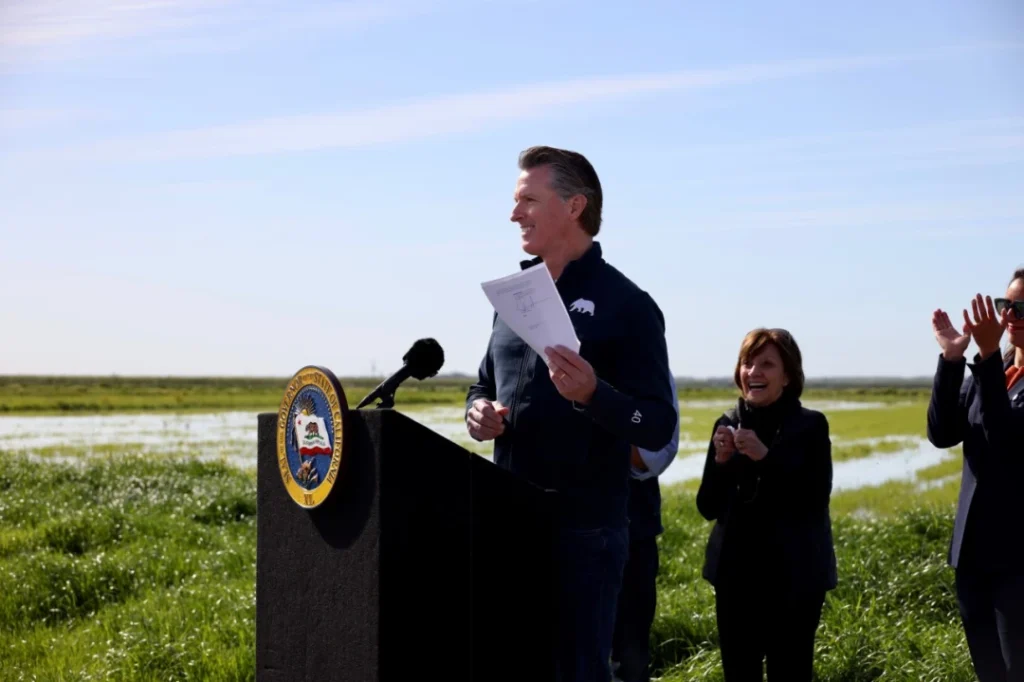California Lifts Water Restrictions as Storms Ease Drought Concerns

California Governor Gavin Newsom has lifted some water restrictions after a winter of abundant rain and snow filled the state’s reservoirs, alleviating concerns about water shortages following three years of severe drought. He also announced that local agencies supplying water to 27 million people and numerous farmers would receive more water from state supplies than initially planned. However, Newsom did not declare the drought over, cautioning that many areas in California are still grappling with its lingering effects.
Nearly two years ago, the Governor had asked Californians to voluntarily reduce their water usage by 15%. As of January, the cumulative savings amounted to only 6.2%. Newsom has now decided to discontinue this request. He is also easing regulations requiring local water agencies to enforce restrictions on customers. Most people will no longer be limited to watering their lawns on specific days or times, although other restrictions, such as a ban on watering decorative grass for businesses, remain in place.
State officials have revealed that California’s reservoirs are now so full that cities will receive more than double the amount of drinking water compared to the previous allocation announced last month. Water districts serving 27 million people will get at least 75% of the water they requested from state supplies, compared to only 5% last year. Wade Crowfoot, Newsom’s secretary of the California Department of Natural Resources, emphasized that it is important to adapt to a new normal and that the drought is not over yet. He referred to the current situation as “weather whiplash,” characterized by intensifying extremes.

In the past three years, the lack of rain and snow had drained reservoirs, hindered hydroelectric power generation, dried up wells in rural areas, and necessitated the transportation of water supplies to certain communities. It also reduced the flow of major rivers and streams, endangering various fish species.
However, since December, California has been hit by at least 12 powerful storms, referred to as “atmospheric rivers.” These storms have caused flooding, closed ski resorts, and left people in mountain communities without electricity for days, prompting emergency declarations from President Joe Biden. Amid the chaos, water has consistently filled California’s reservoirs, with 12 of its 17 major reservoirs now at or above their historical averages for this time of year.
The snowpack in the mountains across the state is already 223% above the April 1 average, which is when it typically peaks. This snow will eventually melt, flowing into reservoirs and potentially causing more floods downstream. Although the U.S. Drought Monitor reports that much of California is no longer in drought, water shortages are still a concern for some areas, particularly in Southern California and parts of the Klamath River basin in the north.
Crowfoot emphasized the need to move beyond traditional water usage and promote conservation, even when not facing a drought. Due to limited storage capacity in the reservoirs, some have had to release water to accommodate incoming storms and snowmelt in the spring. Consequently, the Newsom administration has allowed farmers to extract water from rivers and flood their fields, with the water eventually seeping back underground to refill groundwater basins.
On Friday, Newsom announced the drought-related decisions at a farm in Dunnigan, a community located about 37 miles northwest of Sacramento. State officials hope projects like these will help replenish some of the groundwater that was depleted during the drought. While California’s water situation has improved dramatically, it remains essential to adapt to new conditions and prioritize water conservation to manage the state’s ongoing challenges with drought and extreme weather events.
Attractive section of content. I just stumbled upon your site and in accession capital to assert that I acquire
in fact enjoyed account your blog posts. Anyway I will be subscribing to
your feeds and even I achievement you access consistently quickly.
Its like you read my mind! You seem to know a lot about this, like
you wrote the book in it or something. I think that you can do
with some pics to drive the message home a bit, but other than that, this is fantastic blog.
An excellent read. I’ll certainly be back.
It’s perfect time to make a few plans for the future and it’s
time to be happy. I’ve read this publish and if I could I want to recommend you few
attention-grabbing things or advice. Maybe you can write
subsequent articles regarding this article.
I wish to learn more things approximately it!
I’m not sure where you are getting your information, but great topic.
I needs to spend some time learning much more or understanding more.
Thanks for excellent info I was looking for this info for my mission.
What i do not understood is actually how you
are not actually a lot more smartly-liked than you may
be right now. You’re very intelligent. You recognize therefore considerably when it comes to this topic, produced me personally consider it from
a lot of varied angles. Its like men and women are not fascinated except
it is something to do with Lady gaga! Your own stuffs nice.
Always deal with it up!
Your style is unique compared to other people I have read stuff from.
Thank you for posting when you have the opportunity,
Guess I will just bookmark this web site.